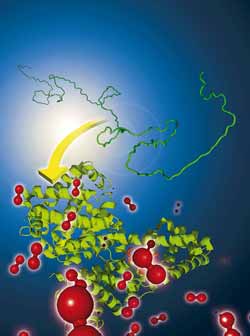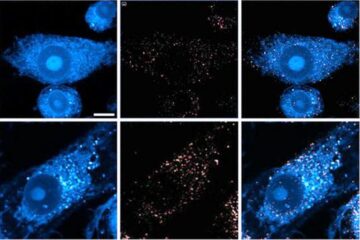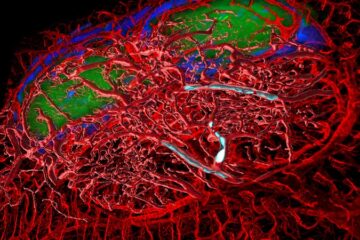The mystery of protein folding

<br>
Living subjects are very complex systems and, at the same time, stunningly robust and accommodative. The secret of success are their proteins which build up the cells of the organisms, act as cleaners, messengers, transporter, motors, and fulfill much more jobs.
How proteins are genetically coded and how their linear chains of amino acids are put together, is in principle well known. Yet, this is not the full story. Before proteins can do their jobs, they have to be folded in a proper way. This is important because the shape determines the function of the protein. And misfolded proteins can cause severe health disorders, such as Morbus Alzheimer. The cause seems to be that they tend to aggregate into so called amyloid plaques.
It is still impossible to predict from the amino acid sequence how the corresponding protein will fold. New insights into the principles or protein folding could enhance the understanding of amyloid based diseases. In addition, protein drugs could be custom tailored for special target molecules.
Nobel laureate Ahmed H. Zewail and his co-worker Milo M. Lin summarize their insights into the physical backgrounds of protein folding in the latest issue of Annalen der Physik (www.ann-phys.org) as part of the renowned Einstein Lectures. This series, established in 2005 in the course of the Einstein Year, comprises articles of reputable scientists such as Nobel laureates Theodor Hänsch, Roy Glauber and Peter Grünberg. Now, Zewail and Lin report about physical views of protein folding.
Many proteins are able to fold themselves quickly and properly into a complicated conformation without any help of a cellular “folding apparatus”. How they achieve this is still a mystery. Zewail and Lin at the California Institute of Technology in Pasadena (USA) want to solve this “protein folding problem“ by looking at the basic physics behind the complex world of proteins.
Besides thermodynamics which control the stability of the possible protein conformers, kinetic aspects play a key role as they rule the mechanisms and time scales of the folding process. A polypeptide chain could spend more time than the age of the universe “trying” all of its possible conformers to find its native one. In reality, folding never takes more than a few seconds.
Using ultrashort laser pulses, Zewail’s team was able to determine how fast the first twist of an alpha-helix is formed. Real-time investigation of chemical reactions with ultrashort laser pulses is one of Zewail’s specialities; his research in this area had been acknowledged with the donation of the Nobel prize in 1999.
The folding of the first helix twist is the fastest step of protein folding; it therefore determins the general speed limit of folding velocity. Without having to know the details of all mechanisms involved, the scientists were able to calculate this general limit with the help of simple analytical models.
The models used are based on a consideration of the torsion angles in the protein backbone plotted in a so called Ramachandran diagram.
Sterically forbidden, restricted and free regions are distinguished. In addition, the polypeptide chain was calculated as a three-dimensional lattice thereby arranging the chain in a way that maximizes contacts between hydrophobic residues reflecting their shielding from the physiological aqueous environment. The polar sidegroups, instead, have to point outwards. This corresponds to the natural conformation of proteins.
Based on their calculations, Zewail and his colleague argue that hydrophobic interactions between non-polar amino acid residues are sufficient to fold a polypeptide chain into its native shape in a reasonable time. But this works only if the chain is not longer than ca. 200 amino acids. This could be an explanation for the observation that proteins are built up of domains: Although proteins, in general, may consist of more than 1000 amino acids, they are often composed of domains of independently folding sub-parts. These domains are on average 100 amino acids long, most of them being less than 200. This would correspond to the theoretically determined length regime for which hydrophobic interactions are sufficient for fast folding.
Lin, M. M.; Zewail, A. H.: Ann. Phys. (Berlin) 524(8), 379-391 (2012)
In this issue: Ann. Phys. (Berlin), Vol.524, No. 8 (2012)
Founded in 1790, Annalen der Physik (AdP) is one of the world's most renowned physics journals with an over 220 years’ tradition of excellence. Based on the fame of seminal papers by Einstein, Planck, and many others, the journal is now tuned towards today's most exciting physics findings. Since 2012, AdP appears with fresh content, a new team, and with a brand-new look. The journal continues to cover all fields of physics starting from the fundamental aspects of nature to the forefront of applied physics. It now welcomes Rapid Research Letters (RRLs), original papers, and review articles. As a modern journal it supports video abstracts and additional online material. The new section “Physics Forum” reports about current highlights in AdP and about the historic relation of recent and ongoing research efforts in physics.
Wiley-VCH Verlag GmbH & Co. KGaA
Rotherstrasse 21
10245 Berlin
Germany
www.wiley.com
T +49 (0)30 47 031 321
F +49 (0)30 47 031 399
ann-phys@wiley.com
www.ann-phys.org
www.wileyonlinelibrary.com
Media Contact
More Information:
http://www.wiley.comAll latest news from the category: Physics and Astronomy
This area deals with the fundamental laws and building blocks of nature and how they interact, the properties and the behavior of matter, and research into space and time and their structures.
innovations-report provides in-depth reports and articles on subjects such as astrophysics, laser technologies, nuclear, quantum, particle and solid-state physics, nanotechnologies, planetary research and findings (Mars, Venus) and developments related to the Hubble Telescope.
Newest articles

Zap Energy achieves 37-million-degree temperatures in a compact device
New publication reports record electron temperatures for a small-scale, sheared-flow-stabilized Z-pinch fusion device. In the nine decades since humans first produced fusion reactions, only a few fusion technologies have demonstrated…

Innovative microscopy demystifies metabolism of Alzheimer’s
Researchers at UC San Diego have deployed state-of-the art imaging techniques to discover the metabolism driving Alzheimer’s disease; results suggest new treatment strategies. Alzheimer’s disease causes significant problems with memory,…

A cause of immunodeficiency identified
After stroke and heart attack: Every year, between 250,000 and 300,000 people in Germany suffer from a stroke or heart attack. These patients suffer immune disturbances and are very frequently…





















